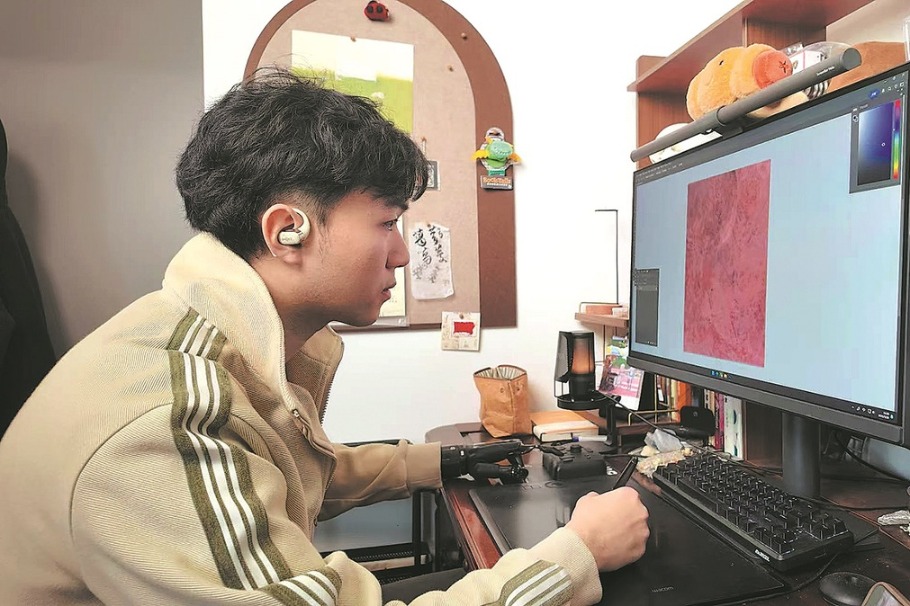Solving the Jiankou jigsaw
Beijing archaeologists analyze historical records and decode stone inscriptions to aid restoration work along a treacherous section of the Great Wall, Wang Kaihao reports.

Perilous and picturesque. These two words best describe the Jiankou section of the Great Wall that ribbons over the top of jagged green mountains in Huairou district, northern Beijing.
While a magnificent landscape makes the over 7-kilometer stretch — built during the final decades of the Ming Dynasty (1368-1644) — a magnet for hikers and photographers, narrow ridges and dangerous cliffs ensure that it remains one of the toughest sections to climb.
A hot spot for daredevil adventures not so long ago, Jiankou has garnered public attention in recent years for dogged restoration efforts, currently in the fourth phase, to prevent towers from crumbling into rubble.
Shang Heng, 38, an associate researcher at Beijing Archaeological Research Institute, and his colleagues are busy solving the restoration riddle, which seems to require more than deep analysis of ancient records. Some clues are probably hidden in the Great Wall itself and the team is leaving no stone unturned to decode them.
Since June, Shang has led a fresh round of archaeological research along the Jiankou section. The ongoing project covers an area of 2,530 square meters. "The Great Wall is a cultural icon of China and many think they know all about it. Nothing could be further from the truth," he says.
"Archaeological study in recent years has deepened our understanding. The Great Wall is more than just a fortified boundary. It is, in fact, a very complex defense installation, which once included towers, ramparts, castles and other fortifications," Shang explains.
Telltale tablets
In Beijing, the extant Great Wall runs for 520 kilometers and was built through a millennium, from the Northern Qi Dynasty (550-577) to the Ming Dynasty.
According to Shang, the Ming rulers began raising the Great Wall soon after the dynasty was founded. However, the fortifications were beefed up once tension began brewing between the dynasty and its northern Mongol neighbors in the 16th century.
Most of the surviving Ming wall sections in Beijing were reinforced during the reigns of Longqing (1567-72) and Wanli (1573-1620).The projects were led by the likes of Zhang Juzheng, the head politician of the imperial government, and the legendary general Qi Jiguang.
Extant historical documentation on the construction of the Great Wall lacks details. For instance, the construction time frame for the Jiankou section remains obscure in the records. Hence, researchers have to depend on field work to anticipate the time needed for restoration.
Stone tablets recently unearthed at the site suggest Jiankou was not built in a hurry. Inscriptions on one tablet indicate that beacon tower No 145 was erected in 1584. Another tablet inscription says the wall connecting towers No 143 and No 144 was constructed in 1597.
A tablet found during the third phase of Jiankou restoration in 2020 suggested that beacon tower No 127 was built in 1617. Another tablet, recently recovered from the half-collapsed tower No 156, shows it was constructed in 1573.
"Although the Jiankou section is not very long, it took more than 40 years and at least two generations to build. In short, individual fortifications were built before the entire Great Wall. It shows the evolution of a defense system," Shang says.
"Archaeological study tells us how a section of the Great Wall was built, developed, used, abandoned and, sometimes, collapsed — almost like a person's life. One gets an impression of the challenges that people faced in creating this architectural wonder."
The Great Wall offers a glimpse into the lives of soldiers stationed on the border centuries ago. On the top of a beacon tower, Shang's team discovered a hearth built to beat harsh winters. It was also used for cooking. "General Qi's books mention soldiers preparing meals on the Great Wall. Our find corroborates the historical record," he says.
Restoration efforts in the olden times were different. Collapsed portions of the Great Wall were often treated as rubble and cleared from the site, Shang regrets. Today, archaeologists are determined to preserve the ruins for future study. "As long as the ruins do not pose a risk to the structure, we will keep them. They are a key source of historical information," Shang says.
Multidimensional mission
Beijing is among the first cities to launch archaeological expeditions at the Ming Dynasty sections of the Great Wall to facilitate restoration work. Earlier this year, Shang had led an excavation project on the Dazhuangke section in Yanqing district.
"Our mission is to understand what ails the Great Wall and how it can be saved. Archaeological evidence tells us how various sections can be restored," he says.
There was much debate on whether some sections should be given a refreshed look after restoration, considering the monumental influence the Great Wall has on Chinese people's psychological strength, or whether the broken facades should be retained to reflect the history they endured.
In a conservation advisory, released by the National Cultural Heritage Administration in 2019, the Great Wall was described as "a heritage made of ancient architecture and ruins". Hence, the focus became restoration instead of renovation.
For Shang, the mission is multidimensional restoration of the Great Wall. "Archaeological findings can offer fundamental clues for virtual restoration work, which means people can see what the Great Wall originally looked like on digital platforms," he says.
He is the only archaeologist at the Beijing institute who's entirely focusing on the Great Wall. He had visited the Badaling section, which is popular with tourists, as a child and began amateur research while in middle school. "It was like wanting to watch an entire television series after seeing a thrilling trailer. In college, I was an archaeology major and finally, it became my career."
Shang has covered on foot the 1,500-km-plus stretch of the Great Wall built during the Ming Dynasty. "I may be old school when it comes to studying history, but I know digital methods are necessary to further our conservation efforts, especially if we want the young generation to contribute," he says.
In June, a WeChat mini-program coproduced by the China Foundation for Cultural Heritage Conservation and internet giant Tencent went online. Shang played a key role in making Great Wall E-tour a reality.
Around 50,000 high-definition pictures of the Xifengkou section in Hebei province have been used to develop the program. A virtual expedition allows enthusiasts to contribute to restoration efforts.
"The experience is immersive. People understand the need to protect the Great Wall and learn to appreciate the achievements of archaeological teams," says Liu Yuzhu, head of the heritage foundation.
During wars throughout history, smoke frequently billowed out of the beacon towers. In times of peace, these structures offered an insight into the society.
"Development of regions along the Great Wall through different dynasties showed how ancient Chinese people managed agrarian and pastoral land," Ge Chengyong, a professor at China Academy of Cultural Heritage, writes in an article. "The Great Wall largely promoted economic exchange in the frontier area and communication among various ethnic groups. It gave an impetus to a united Chinese civilization, rooted in diversity."
Shang agrees and adds that their mission is to unravel every ounce of history hidden along the length of the Great Wall. "We will take it slow. We do not wish to make haste and commit a mistake that cannot be rectified. A colossal archaeological database will be formed. Jiankou is only a start."



Today's Top News
- Tajikistan looks to China for deeper ties
- High-tech manufacturing lifts industrial profits
- Avenue blooms with flowers to mark victory
- Mainland slams DPP for distorting WWII history
- Northeast Asia trade in focus at Jilin expo
- Organic agriculture forum unites global experts in Datong































